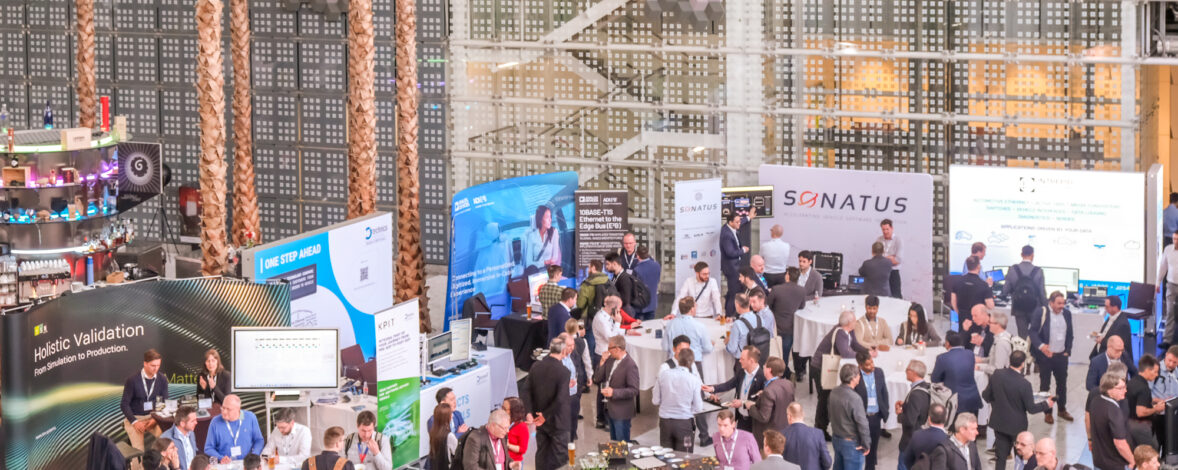The importance of network technology
in the automotive industry
Sonatus attended the Automotive Ethernet Congress in late March in Munich, Germany with more than 1000 attendees, speakers and exhibitors from 26 countries. The event harnessed the energy driving the automotive ethernet ecosystem. As I’ve immersed myself into the automotive technology world, the notion that “software is eating the world” continues to ring in my mind, however, I might change this to read “the network is eating the world.” In vehicles, the software functions resident in isolated components are now exposed to other software functions, some centralized, some in the cloud and potentially others located in neighboring vehicles. The implications for services and applications are profound. This puts enormous pressure on the network in terms of quality of service, bandwidth, reliability, security, power consumption and cost. The Automotive Ethernet Congress offered an opportunity to see how this eaten world may come about through the application of Ethernet technology. Here are three key takeaways:
1. Building performant vehicle networks will be crucial
Ethernet technology is the standard for the wired Internet, public and private. However, the legacy in-vehicle network comprises several alternative technologies including CAN and Flexray. These technologies have favorable characteristics for in-vehicle networks by combining low cost with deterministic performance, but as we look to introduce Internet and cloud technologies into the vehicle, these legacy networks have MTU, bandwidth, efficiency, redundancy and QoS issues.
The 10BASE-T1S PHY addresses issues associated with existing Ethernet PHYs while providing the Ethernet MAC to low cost ECUs, thereby providing network layer connectivity throughout the vehicle without the need for gateways and tunneling schemes. The service oriented architecture can now span directly across all ECUs in a flat architecture that can include cloud and connected vehicle services.
10BASE-T1S specifies a single twisted pair reminiscent of half-duplex 10BASE-T. It can run CSMA/CD but it also has a TDMA mechanism that is very bandwidth efficient. This mode is called PLCA (PHY Level Collision Avoidance). The nice thing about PLCA is that the access period dedicated to a station is very short, 20 bits, but extends to the actual length of the data when there is data to send. A station waits for its access period and then transmits. Once the station transmits, the next station’s transmit opportunity opens for 20 bits, if there is nothing to transmit, only 20 bits are wasted. There is no random backoff period so the network’s worst case performance is deterministic if the number of nodes is known. An 8 node network is very efficient (99.5%) when all nodes need to transmit; and between 78.3% to 98.7% efficient for min to max size frames when only one node is transmitting.
As the network layer reaches lower-cost ECUs, Sonatus in-vehicle software ensures the proper provisioning of these networks to support the bandwidth, QoS and power requirements of their applications.
2. OEMs need energy efficient networks for the EV era
Asymmetric traffic patterns pervade in the vehicle network. Cameras and displays are highly asymmetric in that a camera transmits a lot of video data but receives very little data (mostly control data). Displays receive a lot of data but transmit very little. In both cases the required bandwidths are high.
As such, OEMs are forced to install high bandwidth links between nodes and switches where only one direction of bandwidth is fully used. PHYs consume energy and this can be an issue for electric vehicles where energy efficiency is a primary concern. Running the PHY without any transmission is a waste of energy.
EEE is an IEEE 802 technology developed to solve this problem. The basic idea is to only run the PHY for a fraction of time over some period. To better optimize Ethernet for asymmetric data rates a new Ethernet PHY called ASA 2.0 is being proposed. To take advantage of this optimization the PHY should be configured in accordance with the expected asymmetrical data rates. An SDN solution is a good match for this problem since the network traffic requirements are already needed to solve QoS and reliability problems and this information can be used to solve power management problems.
3. Agile software architecture is necessary
Highlighting the importance of Ethernet switching in the modern vehicle, AutoSAR is developing a data model for Ethernet switch configuration. The model is described at a low level and concerns itself with fundamental switch objects. As such, an application needs to be developed to construct the configuration and deploy it to the switch. In the case of multiple switch networks, such as in a zonal architecture, the application would be responsible for constructing configurations for each switch and distributing it accordingly.
Sonatus has demonstrated switch configuration through switch policies in both single switch and zonal architectures. While it is possible to support the AutoSAR model, Sonatus currently uses IEEE YANG models to generate appropriate configurations for the switches. AutoSAR and IEEE appear to be developing competitive standards for ethernet switch configuration and monitoring models. It’s likely that we will see a mix of approaches across the industry so an agile software architecture will be required to win in this market.
The road to an automated future
The Automotive Ethernet Congress highlighted the growing importance of network technology in the automotive industry. As vehicles become more connected and automated, the network’s quality of service, bandwidth, reliability, security, power consumption, and cost become increasingly critical. With the advancements in Ethernet technology, the industry is moving towards a more connected and automated future, and automakers will need to implement new architectures in order to accelerate the shift to software-defined vehicles.
→ Learn more about Sonatus’ Ethernet Network Manager, a component of Sonatus Foundation Network Services.
James Murphy
Member of Technical Staff, Sonatus
contact@sonatus.com
